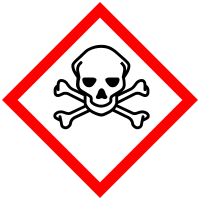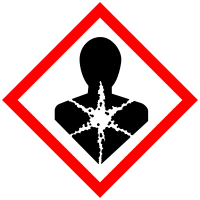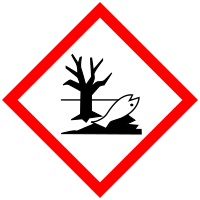
Improving Member States preparedness to face an HNS pollution of the Marine System (HNS-MS)
Acetone Cyanohydrin
Description Top
| CAS number | 75-86-5 |
| UN number | 1541 |
| Chemical formula | C4H7NO |
| Standard European Behaviour Classification (SEBC) | Dissolves (D) |
| Abilities | Miscible in water. |
GESAMP Hazard profile
| A1 | A2 | B1 | B2 | C1 | C2 | C3 | D1 | D2 | D3 | E1 | E2 | E3 |
| 0 | R | 4 | NI | 3 | 4 | 3 | 3 | 3 | NI | D | 3 |
Marine pollution Classification (MARPOL Annex II)
| Category | Description |
| Y | Noxious Liquid Substances which, if discharged into the sea from tank cleaning or deballasting operations, are deemed to present a hazard to either marine resources or human health or cause harm to amenities or other legitimate uses of the sea and therefore justify a limitation on the quality and quantity of the discharge into the marine environment. |
Alternate names for this chemical
2-Hydroxy-2-Methylpropanenitrile
2-Hydroxy-2-Methylpropionitrile
Acetonecyanhydrine
Cyanhydrine D'Acetone
2-Methyllacetonitrile
2-Cyano-2-Propanol
2-Hydroxyisobutyronitrile
Alpha-Hydroxyisobutyronitrile
Acetone Cyanohydrin
Acetone Cyanohydrine
α-Hydroxyisobutyronitrile
2-Hydroxy-2-Methylpropionitrile
Acetonecyanhydrine
Cyanhydrine D'Acetone
2-Methyllacetonitrile
2-Cyano-2-Propanol
2-Hydroxyisobutyronitrile
Alpha-Hydroxyisobutyronitrile
Acetone Cyanohydrin
Acetone Cyanohydrine
α-Hydroxyisobutyronitrile
Physico-chemical properties Top
| Chemical formula | C4H7NO | ||
| Molar mass | 85.11 [g/mol] | ||
| State | Liquid at 25°C and 1 atm | ||
| Fusion temperature | -19 [°C] | ||
| Density |
|
||
| Hydrosolubility |
|
||
| Vapour pressure |
|
||
| Vapour density | 2.4 | ||
| Flash point (Pensky-Martens closed cup) | 73.9 [°C] | ||
| Flash point (Cleveland open cup) | 74 [°C] | ||
| Lower explosivity limit (LEL) | 2.2 [%] | ||
| Upper explosivity limit (UEL) | 12 [%] | ||
| Combustion enthalpy | 26300000 [J/Kg] | ||
| Combustion efficiency | 95 [%] | ||
| Mass flow rate of the combustion surface | 0.03 [Kg/(m²·s)] | ||
| Radiative fraction | 22 [%] | ||
| Henry's constant | 0.34 [mol/(m³·Pa)] |
Behaviour Top
| Log Kow | -0.03 |
| Log Koc | 1.08 |
| Hydrolysis (Half-life) | 1 day |
| Standard European Behaviour Classification (SEBC) | Dissolves (D) |
| Bioconcentration factor (BCF) | 1 |
Ecotoxicity Top
| Lowest median lethal concentration (LC50) on algae | 1.25 [mg/l] | ||
| Lowest median lethal concentration (LC50) on crustacean | 0.13 [mg/l] | ||
| Lowest median lethal concentration (LC50) on fishes | 0.22 [mg/l] | ||
| Assessment factor (AF) |
|
||
| Predicted No Effect Concentration (PNEC) |
|
Hazards Top



Danger
Hazards statements
Health
H300
Fatal if swallowed.
H310
Fatal in contact with skin.
H330
Fatal if inhaled.
H370
Causes damage to organs.
Environmental
H400
Very toxic to aquatic life.
H410
Very toxic to aquatic life with long lasting effects.
Precautionary statements
Prevention
P280
Wear protective gloves/protective clothing/eye protection/face protection.
P284
Wear respiratory protection.
Response
P302 + P350
IF ON SKIN: Gently wash with plenty of soap and water.
Storage
P403 + P233
Store in a well-ventilated place. Keep container tightly closed.
Disposal
P501
Dispose of contents/container to ...
GESAMP Top
GESAMP Hazard profile
| A1 | A2 | B1 | B2 | C1 | C2 | C3 | D1 | D2 | D3 | E1 | E2 | E3 |
| 0 | R | 4 | NI | 3 | 4 | 3 | 3 | 3 | NI | D | 3 |
A1: Bioaccumulation
| Rating | Description |
| 0 | No potential to bioaccumulate |
A1a:
| Rating | Description | Criteria [mg/l] |
| 0 | No potential to bioaccumulate | Log Kow < 1 |
A1b:
| Rating | Description | Criteria |
| 0 | No potential to bioaccumulate | No measurable bioconcentration factor (BCF) |
A2: Biodegradation
| Rating | Description |
| R | Readily biodegradable |
B1: Acute aquatic toxicity
| Rating | Description | Criteria [mg/l] |
| 4 | Highly toxic | 0.1 < LC/EC/IC50 ≤ 1 |
B2: Chronic aquatic toxicity
| Rating | Description |
| NI | No Information |
C1: Acute oral toxicity
| Rating | Description | Criteria [mg/Kg] |
| 3 | Moderately high | 5 < AOTE ≤ 50 |
C2: Acute dermal toxicity (skin contact)
| Rating | Description | Criteria [mg/Kg] |
| 4 | High | ADTE ≤ 50 |
C3: Acute inhalation toxicity
| Rating | Description | Criteria [mg/l] (4 hours exposure) |
| 3 | Moderately high | 0.5 < AITE ≤ 2 |
D1: Skin irritation or corrosion
| Rating | Description | Sign | GHS category |
| 3 | Severely irritating or corrosive | Severe irritation indi | Corrosive Category 1 |
D2: Eye irritation
| Rating | Description | Sign | GHS category |
| 3 | Severely irritating or corrosive | Severe conjunctoblepha | Irritant Category 1 |
D3: Long-term health effects
| Notation | Hazard endpoint | Description | GHS category |
| No Information |
E1: Tainting of seafood
| Rating | Description |
| NI | No Information |
E2: Behaviour of chemicals in the marine environment
| Rating | Description |
| D | Dissolves |
E3: Interference with the use of coastal amenities
| Rating | Interference | Description | Interpretation | Warning |
| 3 | Highly objectionable | 1 is highly acutely toxic; and/or 2 is severely irritant or corrosive to skin or eyes; and/or 3 is carcinogenic, mutagenic or reprotoxic; and/or 4 is a floater or persistent floater with associated health effects | 1 C1 and/or C2 and/or C3 = 4; and/or 2 D1 or D2 = 3, 3A, 3B, or 3C; and/or 3 D3 contains C, M or R; and/or 4 E2 = F or Fp and D3 contains Ss, Sr, T, A, N, or I | Warning issued leading to the closure of amenities |
GHS Security Information



Danger
About the project
HNS-MS is a decision-support tool that Belgian and French maritime authorities as well as coastguard stations can activate in order to forecast the drift, fate and behavior of acute marine pollution by Harmful Noxious Substances (HNS) accidentally released in the marine system.
Contact us
Copyright © 2015–2026 HNS-MS Consortium
 HNS-MS has been funded by DG-ECHO under agreement ECHO/SUB/2014/693705 and runs from 1 January 2015 to 31 March 2017.
HNS-MS has been funded by DG-ECHO under agreement ECHO/SUB/2014/693705 and runs from 1 January 2015 to 31 March 2017.